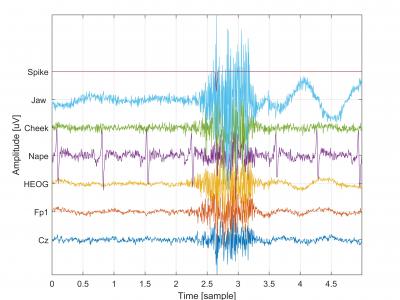EMG
Synthetic EEG Dataset for CNN Training: Clean and Artifact-Contaminated Signals
This dataset consists of synthetically generated EEG and EMG signals designed for training Convolutional Neural Networks (CNNs) in artifact detection and removal. The dataset includes both clean EEG signals and EEG signals contaminated with simulated EMG artifacts from various sources.
- Categories:
 218 Views
218 ViewsSynthetic Epileptic Spike EEG Database (SESED-WUT)
The database contains EEG, EMG, and EOG signals with artificially generated epileptic spikes. The recordings were performed using the g.USBamp 2.0 amplifier. Data were collected from 5 EEG channels (C3, Cz, C4, Fz, Fp1), 1 EOG channel (VEOG), and 3 EMG channels (Nape, Cheek, Jaw). The signals were sampled at 256 Hz and processed with a bandpass filter (0.1–100 Hz) and a notch filter (48–52 Hz).
- Categories:
 239 Views
239 Views
In this study, we collected EEG and EMG data from 16 subjects during the MI process and constructed a homemade MI-hBCI dataset. The participants included 10 males (mean age: 22.3±3.1 years) and 6 females (mean age: 22.1±2.4 years). All the subjects were right-handed, had normal vision, and had no motor impairment; all the participants signed a consent form and were informed of the experimental procedure and precautions before the experiment.
- Categories:
 194 Views
194 Views
<p>Ten individuals in good health were enlisted to execute 16 distinct movements involving the wrist and fingers in real-time. Before commencing the experimental procedure, explicit consent was obtained from each participant. Participants were informed that they had the option to withdraw from the study at any point during the experimental session. The experimental protocol adhered to the principles outlined in the Declaration of Helsinki and received approval from the local ethics committee at the National University of Sciences and Technology, Islamabad, Pakistan.
- Categories:
 136 Views
136 Views
<p><span style="font-size: 10.0pt; font-family: 'Times New Roman',serif; mso-fareast-font-family: 'Times New Roman'; border: none windowtext 1.0pt; mso-border-alt: none windowtext 0in; padding: 0in; mso-ansi-language: EN-US; mso-fareast-language: EN-US; mso-bidi-language: AR-SA;">Many neurophysiological measurements are affected by mental state tasks.
- Categories:
 323 Views
323 ViewsThe design and implementation of an anthropomorphic robotic hand control system for the Bioengineering and Neuroimaging Laboratory LNB of the ESPOL were elaborated. The myoelectric signals were obtained using a bioelectric data acquisition board (CYTON BOARD) using six channels out of 8 available, which had an amplitude of 200 [uV] at a sampling frequency of 250 [Hz].
- Categories:
 2292 Views
2292 Views

